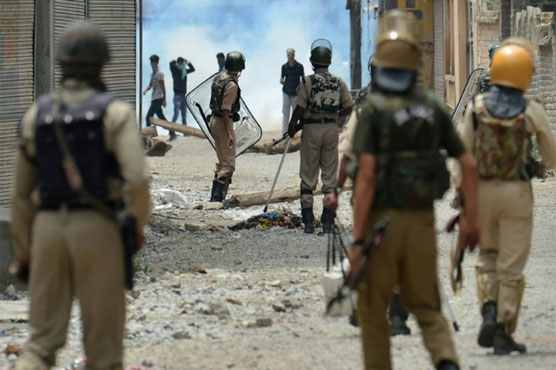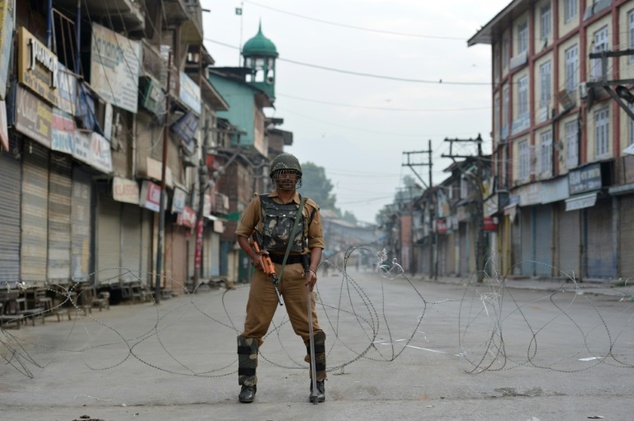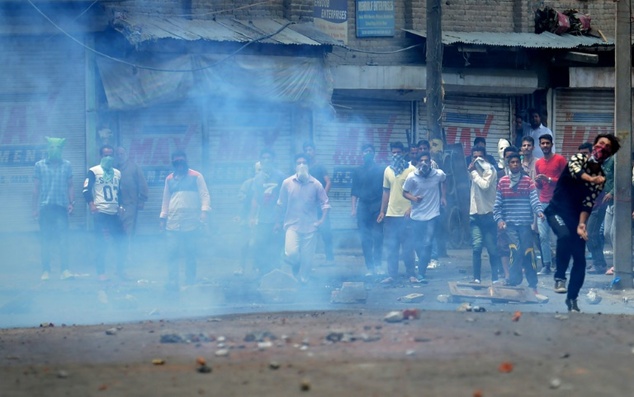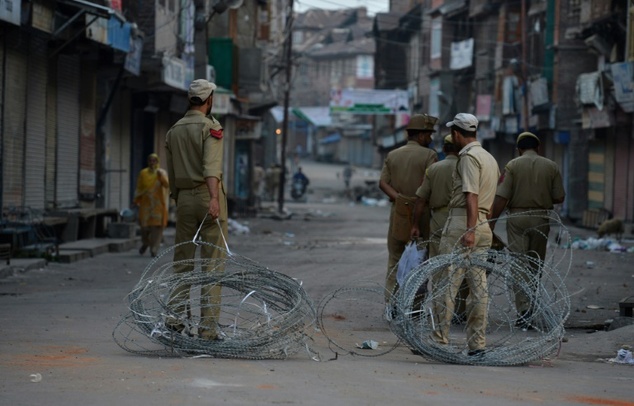Death toll in Kashmir violence rises to 23

Another 200 people have been wounded in the violence, many of them protesters.
SRINAGAR, India (AFP / APP) - Five people including a teenage girl were killed in overnight clashes between protesters and government forces in India-held Kashmir after a popular separatist leader was shot dead, police said Monday, taking the toll to 23.
Hundreds more have been wounded in the demonstrations that broke out on Saturday despite a curfew imposed across much of the Kashmir Valley, where government forces have repeatedly opened fire on protesters in the worst civilian unrest since 2010.
Life in the valley was paralysed for a third day Monday with shops and businesses closed, and there were reports people were once again defying the curfew to come out onto the streets.
The protests follow the killing on Friday of Burhan Wani, a 22-year-old alleged commander of Kashmir’s largest separatist group Hizbul Mujahideen (HM), during a gun battle with government forces.
HM is one of several groups that have for decades been fighting around half a million Indian troops deployed in the region, calling for independence.
Around 300 people have been injured, including nearly 100 police, and hospitals say they are overwhelmed. Most victims suffered gunshot wounds or teargas inhalation.
There were also reports of injured protesters being targeted -- one local doctors’ association said Sunday that tear gas canisters had been fired inside a hospital emergency room.
Another group, the India-held Kashmir Coalition for Civil Society, alleged that police had attacked ambulances taking the wounded to hospital.
Meanwhile police said protesters had set police stations on fire and thrown rocks at army camps in the south of the restive region.
 An Indian paramilitary troop stands guard during a curfew in Srinagar on July 10, 2016 (AFP Photo)
An Indian paramilitary troop stands guard during a curfew in Srinagar on July 10, 2016 (AFP Photo)
Among the dead was a police officer who drowned when angry protesters pushed an armoured vehicle into a river on Sunday.
The state government has called for calm and has also cut off internet and mobile phone networks to try to stop the protests spreading.
"They (protesters) should not take their protests to a level where a man holding a gun is forced to open fire," said spokesman Nayeem Akhtar on Sunday.
It is the worst civilian violence to hit the restive region since 2010, when mass protests broke out against Indian rule.
Kashmir has been divided between rivals India and Pakistan since 1947, but both claim the territory in its entirety.
Tens of thousands of people, mostly civilians, have died in the fighting since 1989.
Violence has sharply declined in recent years following a major crackdown by the hundreds of thousands of forces deployed in the region.
But a recent uptick in militant attacks has galvanised frustrated young Kashmiris, many of whom deeply resent the military’s presence.
Wani joined the HM rebel group at the age of just 15 after his brother was allegedly tortured by government forces, and quickly became a rallying point for Kashmir’s youth.
The state’s former chief minister Omar Abdullah tweeted after his death that he had become the "new icon of Kashmir’s disaffected".
Witnesses said tens of thousands attended his funeral on Saturday despite the curfew, chanting independence slogans and firing pistol shots in his honour.
 Kashmiri protestors clash with Indian police in Srinagar on July 10, 2016, as the death toll climbed to 21 after two days of unrest (AFP Photo)
Kashmiri protestors clash with Indian police in Srinagar on July 10, 2016, as the death toll climbed to 21 after two days of unrest (AFP Photo)
On the other hand, Syed Ali Gilani, Mirwaiz Umar Farooq, Shabbir Ahmad Shah, Muhammad Yasin Malik, Mohammad Ashraf Sehrai, Altaf Ahmed Shah, Agha Syed Hassan Al-Moosvi Al-Safvi, Nayeem Ahmad Khan, Javaid Ahmed Mir, Qazi Yasir, Ayaz Akbar, Showkat Ahmad Bakhshi, Noor Muhammad Kalwal and many other Hurriyet leaders continued to remain either in police custody or under house arrest.
Prime Minister (PM) Nawaz Sharif Sunday expressed his deep shock over the killing of Kashmiri leader Burhan Wani and many other civilians in the Indian Occupied Jammu and Kashmir by the Indian military and paramilitary forces.
“It is deplorable that excessive and unlawful force was used against the civilians who were protesting against the killing of Burhan Wani,” the Prime Minister said in his statement.
He said such oppressive measures could not deter the valiant people of held-Kashmir from their demand of exercising their right to self determination in accordance with the resolutions of the UN Security Council.
The Prime Minister expressed serious concern over the continued detention of the Kashmiri leadership in Indian Occupied Kashmir and called upon the Indian government to fulfill its human rights obligations as well as its commitments under the UN Security Council’s resolutions.
Uptick in violence
It is the worst civilian violence to hit the restive region since 2010, when mass protests broke out against Indian rule.
Wani joined the HM group at the age of just 15, and was viewed as a hero by many in Kashmir. The state’s former chief minister Omar Abdullah tweeted after his death that he had become the "new icon of Kashmir’s disaffected".
Witnesses said tens of thousands attended his funeral on Saturday despite the curfew, chanting independence slogans and firing pistol shots in his honour.
HM is one of several groups that for decades have been fighting around half a million Indian troops deployed in the region, calling for independence for Kashmir or a merger with Pakistan.
 Indian police set up a road-block during a curfew in Srinagar on July 10, 2016 ©Tauseef Mustafa (AFP)
Indian police set up a road-block during a curfew in Srinagar on July 10, 2016 ©Tauseef Mustafa (AFP)
Kashmir has been divided between rivals India and Pakistan since 1947, but both claim the territory in its entirety.
Tens of thousands of people, mostly civilians, have died in the fighting since 1989.
Violence has sharply declined in recent years following a major crackdown by the hundreds of thousands of forces deployed in the region.
But a recent uptick in militant attacks has galvanised frustrated young Kashmiris, many of whom deeply resent the military’s presence.
In recent months there have been several instances of protesters converging on the scene of gunbattles, throwing stones and hurling abuse at security forces to provide a distraction and enable trapped rebels to escape.
WATCH VIDEO:

